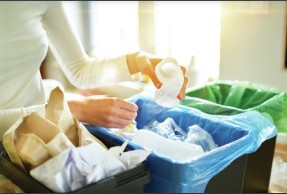

Dear Recycle Lady,
How many kinds of recyclable plastics are there? Are there some non-recyclable plastics?
Plastics are Confusing
Dear Plastics are Confusing,
There are four types of recyclable plastics and three types of non-recyclable plastics.
The four types of recyclable plastics are PET, HDPE, LDPE, and PP.
1. Polyethylene Terephthalate or PET or PETE (#1 plastics) PET is the most commonly recycled plastic and the easiest plastic to recycle. They can be melted, cooled, and reheated multiple times as they are 100% recyclable. Single-use clear plastic water, beer, and soft drink bottles are made of PET plastics. These bottles should not be reused as they absorb bacteria and flavors and are difficult to clean. PET plastics are made into new containers, carpets, furniture, fillings for cushions, fleeces, and polyester fabrics.
2. High Density Polyethylene or HDPE (#2 plastics) HDPE plastics are very strong, durable, and widely recycled. HDPE comes in two forms – soft plastic (freezer bags, plastic bags, and food packaging) and rigid plastic (milk jugs, household cleaners, and detergent bottles). HDPE plastics can be clear or colored and don’t transmit chemicals into food. Kids toys, outdoor furniture, hard hats, wire & cable covers, and plastic wood composites are all made of HDPE plastics. During World War II, Polyethylene was used to protect underwater cabling and as an insulating material for radar on airplanes.
3. Low Density Polyethylene (LDPE) (#4 plastics) LDPE plastics are soft flexible plastics that are made six-pack rings, chemical tank linings, automobile parts, and packaging for computer hardware. LDPE plastics can be recycled in some locations, but not locally.
4. Polypropylene or PP (#5 plastics) PP plastics are a tough, rigid crystalline thermoplastic. Like the LDPE, it can be recycled in some locations, but not locally. Plastic straws, packing tapes, medical components, crates, garden rakes, brooms, and brushes are made of PP plastics.
The three non-recyclable plastics are PVC, PS, and OTHER plastics.
1. Polyvinyl Chloride or PVC plastics (#3 plastics) PVC plastics are available in two categories: flexible and rigid. Cling film, plastic pipes, hoses, and credit cards are made of PVC plastics. PVC plastics can be a health hazard as they release toxins that cause respiratory problems when ingested.
2. Polystyrene or PS plastics (#6 plastics) PS plastics also pose health hazards as they have a high percentage of toxic chemicals. PS plastics include all form products like Styrofoam and some hard plastics. PS plastics are commonly used to make plastic utensils, meat trays, insulations, and refrigeration trays.
3. OTHER plastics (#7 plastics) OTHER plastics include bioplastics and plastic-coated wrapping paper. They also include polycarbonates that contain the industrial chemical bisphenol-A (BPA), which is used to harden plastics. Some research suggests that exposure to BPA may lead to health problems as it leaches into food, beverages, plastic water bottles, and food containers. Acrylic, nylon, and fiberglass are made with OTHER plastics. The safest way to store food or leftovers is to use glass or silicon containers.
Kudos to Costa Rica that has made it illegal to fish for hammerhead sharks. Hammerhead sharks are mostly fished for sport or to harvest their fins to use in shark fin soup. (fto.com)
Have questions about recycling, or interesting information about recycling? Send questions or requests to recyclelady@greenbrier-swa.com. Dear Recycle Lady is sponsored jointly by the Greenbrier Recycling Center and Greenworks Recycling.

